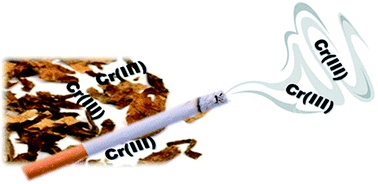Complementary HPLC-ICP-MS and synchrotron X-ray absorption spectroscopy for speciation analysis of chromium in tobacco samples
Abstract
Speciation data for chromium in tobacco products, as obtained by complementary HPLC-ICP-MS and synchrotron-based X-ray Absorption Near-Edge Structure spectroscopy (XANES), are presented for the first time. Non-denaturing extraction conditions were investigated to avoid Cr species redox inter-conversion before analysis of extracts using HPLC-ICP-MS. Methodology based on HPLC-ICP-MS, which is compatible with the extraction conditions, was developed for separation and detection of inorganic Cr species such as Cr(III) and Cr(VI) in aqueous standard solutions. The instrumental limits of detection (3σ criterion) obtained for Cr(III) and Cr(VI) were 0.12 and 0.08 ng g−1 Cr, respectively. The total Cr extracted from 3R4F cut tobacco with water was around 10% of the total Cr in the solid (1949 ± 171 ng g−1 of Cr on a dry weight basis), with 75% of the aqueous Cr associated with species of molecular mass > 3 kDa. Cr(III) was the main identified species in the tobacco extracts using HPLC-ICP-MS, whilst Cr(VI) could not be detected. In situ XANES analysis revealed that the cut tobacco from 3R4F reference cigarettes contained only Cr(III). Following leaching with water, leaching with sodium dodecylsulfate (SDS) on the solid residue led to extraction of a further 10% of the Cr contained in the solid tobacco. The total Cr data obtained by ICP-MS for HNO3 and HNO3/HF acid digests of 3R4F cut tobacco suggested that additional 12% of the total Cr in the solid appears to be associated with silicates, which are known to occur naturally in tobacco products. Although Cr species could not be detected in water leachates from 3R4F smoke condensates using the HPLC-ICP-MS method developed here, XANES measurements identified Cr(III) as the main Cr species present in cigarette smoke condensate, with no detectable Cr(VI). HPLC-ICP-MS data obtained for smoke condensates from cigarettes spiked with Cr(III) before smoke collection revealed that Cr(III) is the main Cr species in present the water soluble fraction of the condensate. Spiking experiments demonstrated that Cr(VI) was highly unstable in trapped smoke condensate. In this work no evidence was observed for the presence of Cr(VI) in mainstream smoke generated from 3R4F cigarettes.

- This article is part of the themed collection: Speciation Analysis

 Please wait while we load your content...
Please wait while we load your content...